THE WOODS NEXT TO THE TURF FARM
(Waterman Research Laboratory)
(scroll to end for High and Low CC plants)
Since it’s close to home and schwork (that’s what I call work because I work at a school), for years I’ve been going to this woodlot tucked into the northwest corner of the Waterman Research Laboratory on Kenny Road. It’s quite disturbed and not the world’s most pristine or undisturbed forest, but as you can see on the map below, it’s an amazing island of nature in a sea of suburban sprawl.
I started this survey in Autumn Semester 2019, so this Summer 2021 report is a continuation of that project rather than a fresh start.
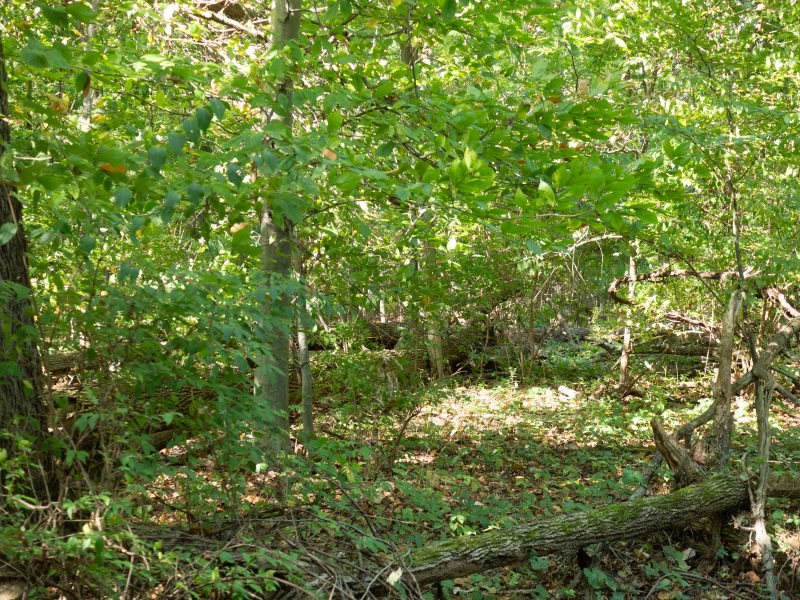
Turf Farm woods.
A fairly common small tree here is pawpaw, Asimina triloba (family Anonaceae, the custard-apple family). This is a clonal tree with a southern affinity (we are near the northern limit of its range). The National Park Service, in an interesting online article called “Pawpaw: Small Tree, Big Impact!” reports that there has recently been an expansion of pawpaw from lowland habitats into drier upland forests, a phenomenon that appears to be attributable to by deer finding pawpaw foliage unpalatable. Goodbye spicebush, hello pawpaw, thanks to deer, I guess.
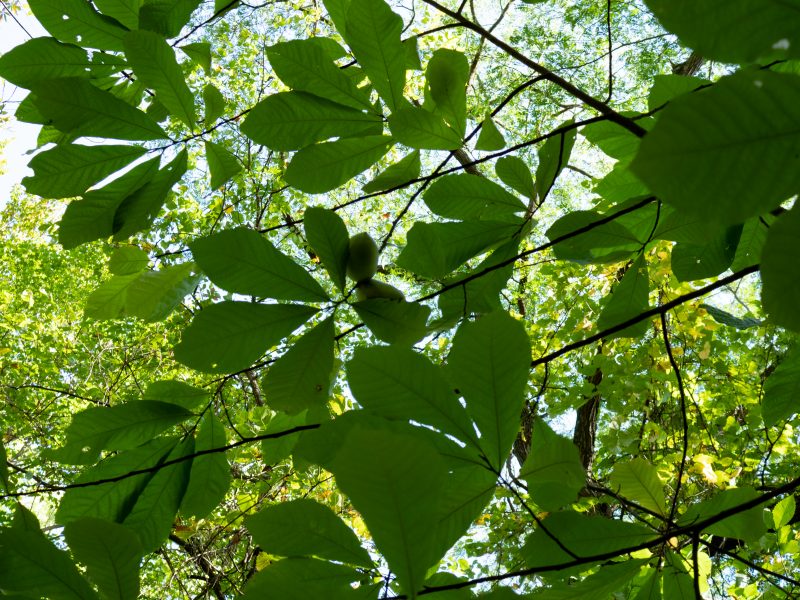
Pawpaw is a small clonal tree with large berries that ripen in early fall.
The plants produce bisexual flowers, but are not self-compatible, so cross-pollination is necessary to produce fruit. There are fruit!!
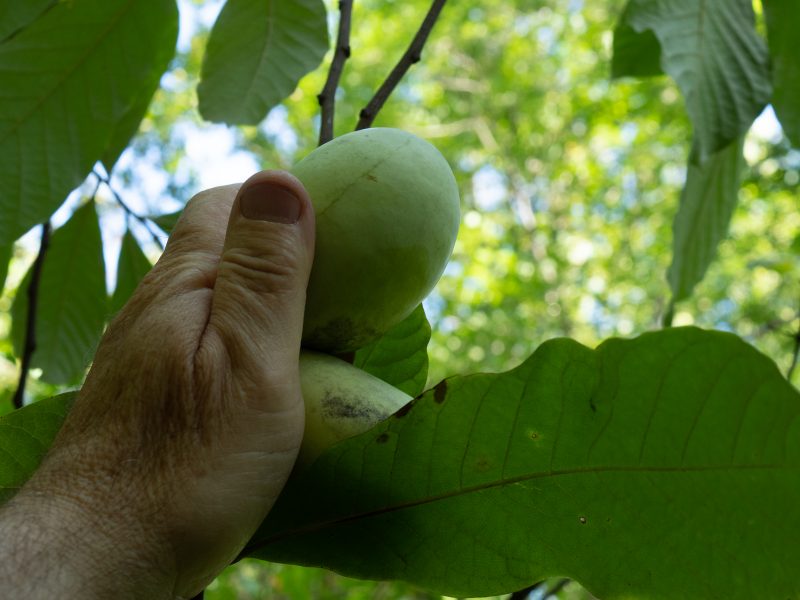
Picking up pawpaws, putting them in your pockets!
If I’m right about this, this is a surprise. This tree with opposite pinnately compound leaves is obviously an ash, but which one? There are more leaflets than usual, and they are sessile (unstalked). I think we have black ash, Fraxinus nigra!
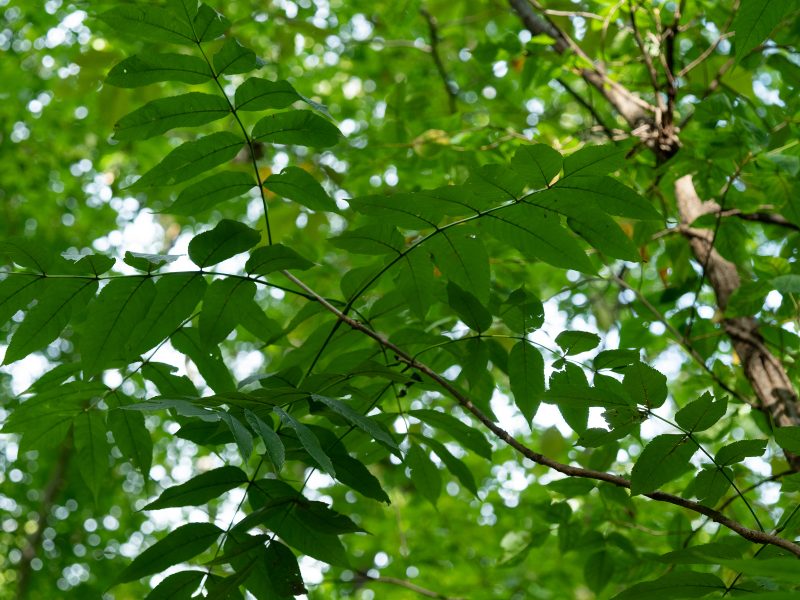
Black ash is a surprise to see!
Spicebush, Lindera benzoin (Lauraceae, the laurel family) is a native shrub, well known for its spicy-smelling leaves and for being a food plant for the spicebush swallowtail butterfly. Sassafras is another aromatic woody plant in the laurel family.
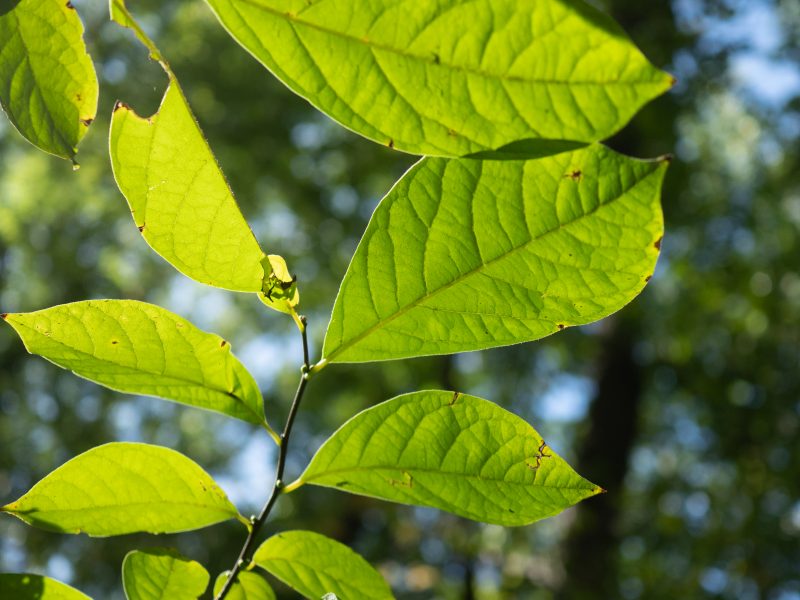
Spicebush has obovate leaves.
Privet, Ligustrum vulgare (Loeaceae, the olive family) is a European shrub that is quite invasive. It has glossy opposite leaves with an entire margin.
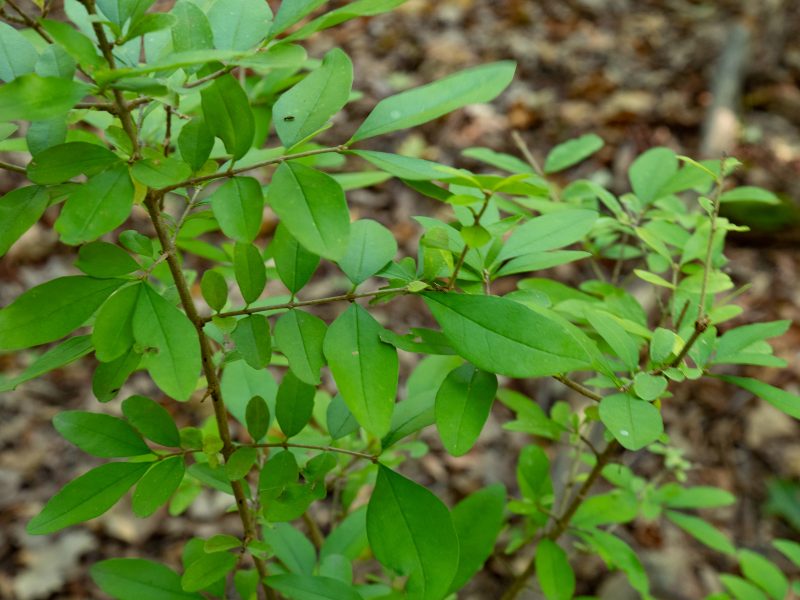
Privet is an invasive shrub.
Flowers are scare indeed this time of year, and especially so during this very dry summer. There are some plant in fruit though. One of them is a species that dispersed by sticking tightly to animal fur and people’s clothing. It’s stickseed, Hackelia virginicca, a native wildflower in the borage family (Boraginaceae).
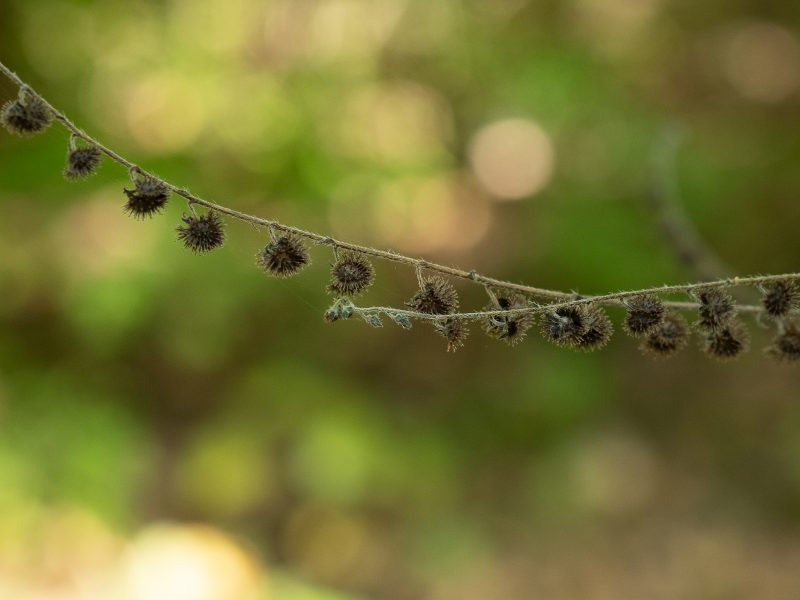
Stickseed is an annoying plant!
Here’s a plant with fruits that are rather the opposite of stickseed’s sticky things: shiny round druped that are edible, but just barely. This is hackberry, Celtis occidentalis, a tree in the elm family (Ulmaceae). In an interesting blog post, James R. Fazio calls hackberry “one tough tree,” in reference to its suitability for planting in harsh settings. He tells us “It has a growth habit that resembles elm (without elm’s susceptibilities to disease), and its berries and leaves serve a wide variety of wildlife.”
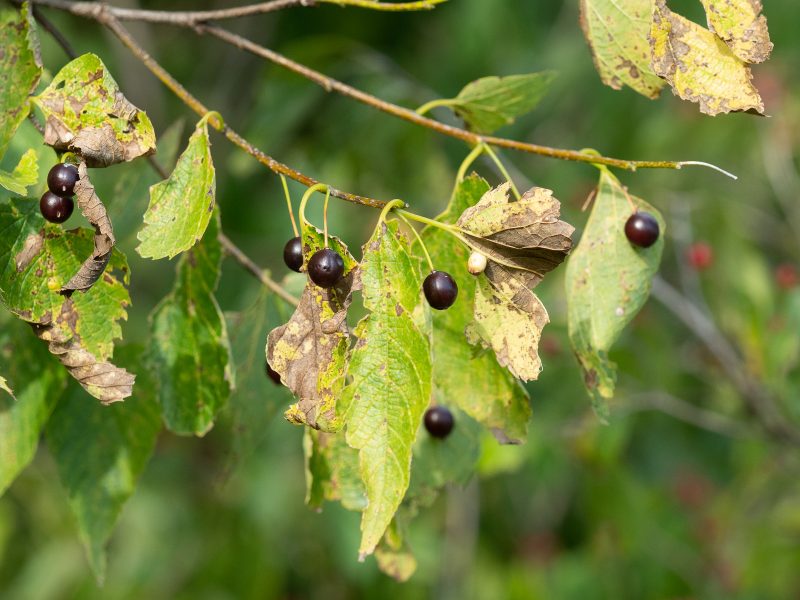
Hackberry drupe have a thin fleshy layer surrounding the seed.
This layer is edible, tasting like dates.
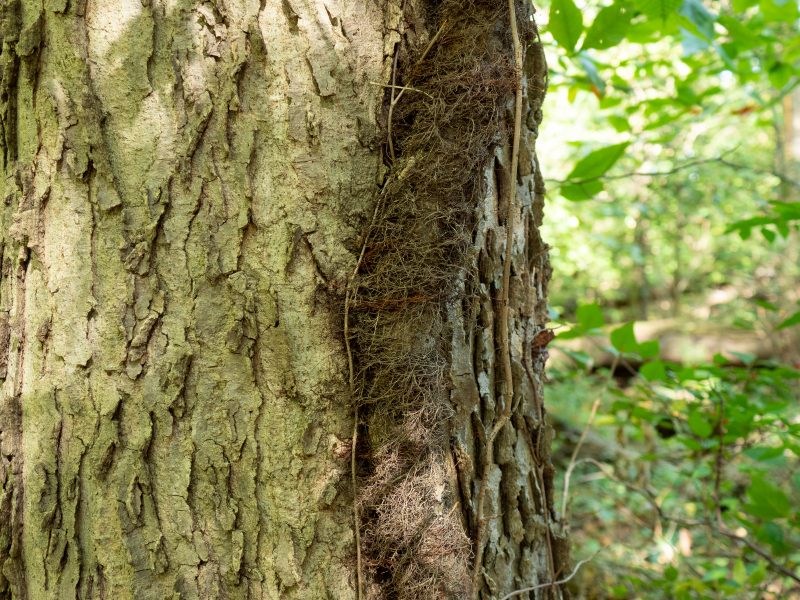
Grab this rope? I’d say “nope.”
There’s a fair amount of poison-ivy at the site. Some of it is in the form of huuuge vines that are attached to mature trees. Such a vines is recognizable as being like a hairy rope.
In an open area at the edge of the wood there is extensive growth of poison-ivy as a ground cover, growing upright so as to look almost shrubby. Yikes!

Poison ivy on the ground.
PLANT COMMUNITIES AT THE WOODLOT SITE
Three communities types are evident at the woodlot site: (1) a border along the parking lot, approximately 50 m x 20 m that is dominated by herbaceous plants and is being invaded by a few woody vines and shrubs; (2) a 200 m long approximately 4 m wide pipeline path right-of-way along the western edge of the woodland; and (3) the woods itself.
The border is dominated by annual and biennial weeds, some native and many introduced.
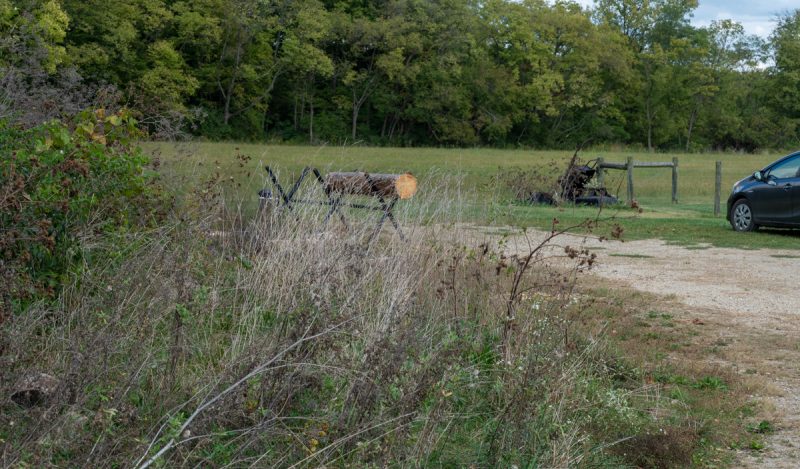
The most disturbed community is a border dominated by weeds.
One of the plants here is giant burdock, Arctium lappa. This adventive member of the aster family is well known for being annoying because the hooked involucral bracts, an adaptation for animal fruit dispersal, cause it to stick velcro-like to your clothing and your pets. This is carrying it too far though. Just in case you don’t already not like burdock, consider that this blue-gray gnatcatcher is no longer catching blue-gray gnats because of it.
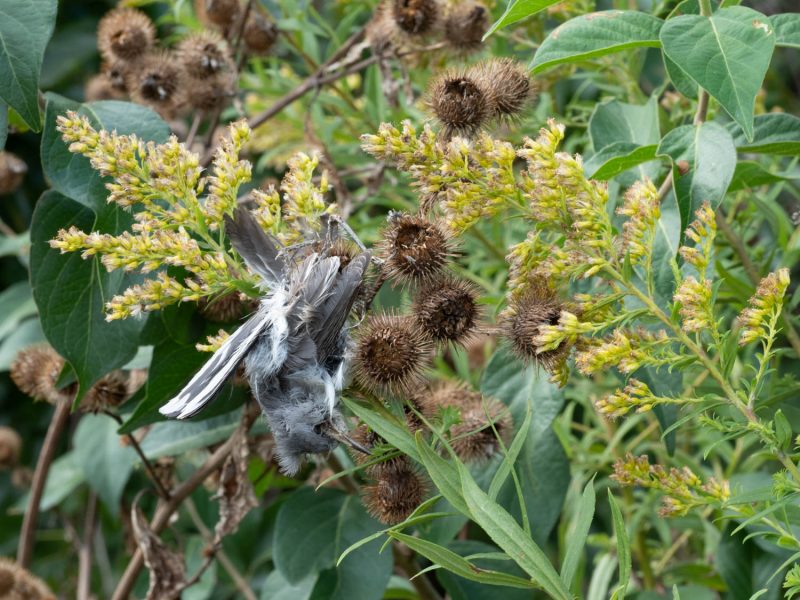
A blue-gray gnatcatcher got caught on burdock.
Along the western edge of the study site is a path kept somewhat clear because it is a pipeline right-of-way. Shadier, lower and wetter than the disturbed site, but more open and disturbed than the woods, it contain some plants found in both these places, as well as some –for example Frank’s sedge (Carex frankii), devil’s beggar-ticks (Bidens frondosa), and Maryland figwort (Scrophularia marylandica).
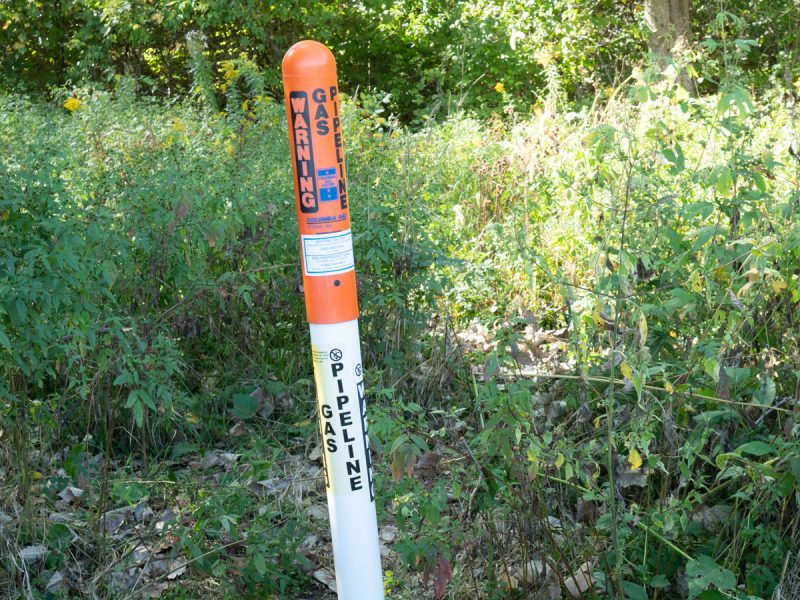
The path is a pipeline right-of-way that is intermediate between the woods and the border.
Inspired by something the President said, while surveying that plants along this path, I investigated the Bidens. This is “devil’s beggar-ticks,” Bidens frondosa, a native but weedy stick-tight. This is another Asteraceae member that disperses by sticking to animals, but this one does so via projections on the achenes –pappus bristles with stiff backwards-pointing bristles.
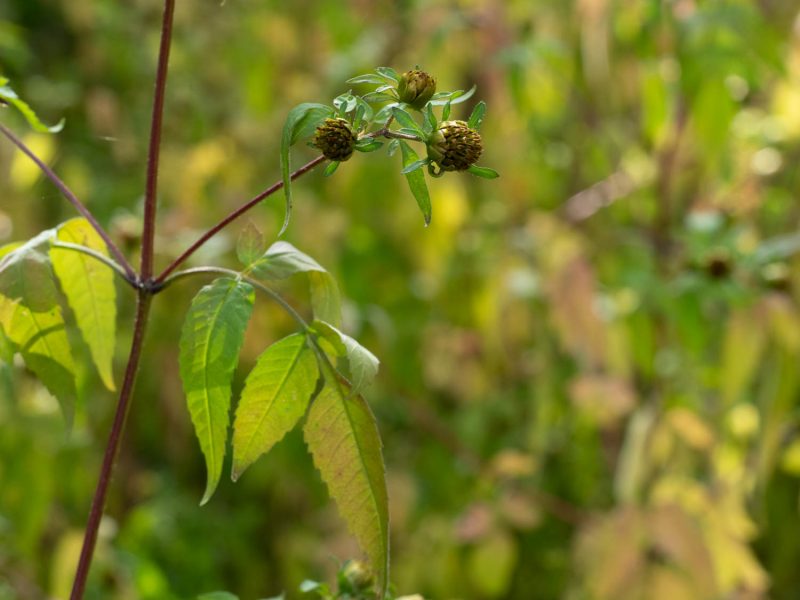
Devil’s beggar-ticks is a rayless composite.
The woodland is dominated by forest trees, including American Beech (Fagus grandifolia), sugar maple (Acer saccharum), and pawpaw (Asimina triloba). The understory is fairly open, probably due to heavy deer browwing. There are a few shrubs –notable invasive ones such as Amur honeysuckle (Lonicera maackii) and multiflora rose (Rosa multiflora), but with a fair amount of the lovely native spicebush (Lindera benzoin) as well.
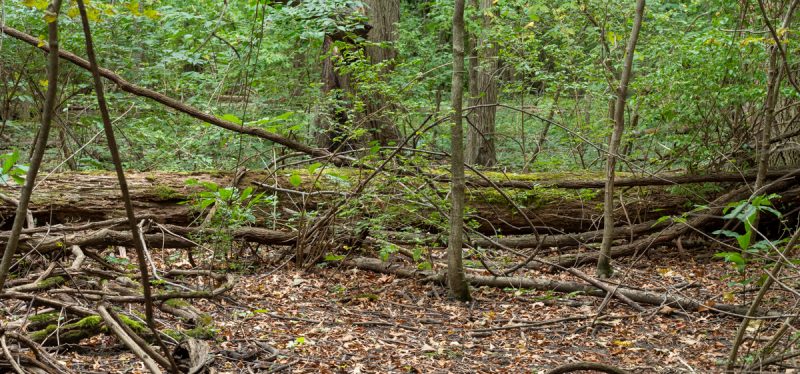
The woods are lovely, but severely affected by emerald ash borer and deer browsing.
In part because of the emerald ash borer, there are a lot of logs on the ground in these woods. They are good substrate for mosses. One of the mosses thriving here is a shiny pleurocarp, Entodon seductrix. It was nice to see that, as evidenced by the young sporophytes present that despite the parched conditions of late, moss sperm was nonetheless able to swim to moss eggs!
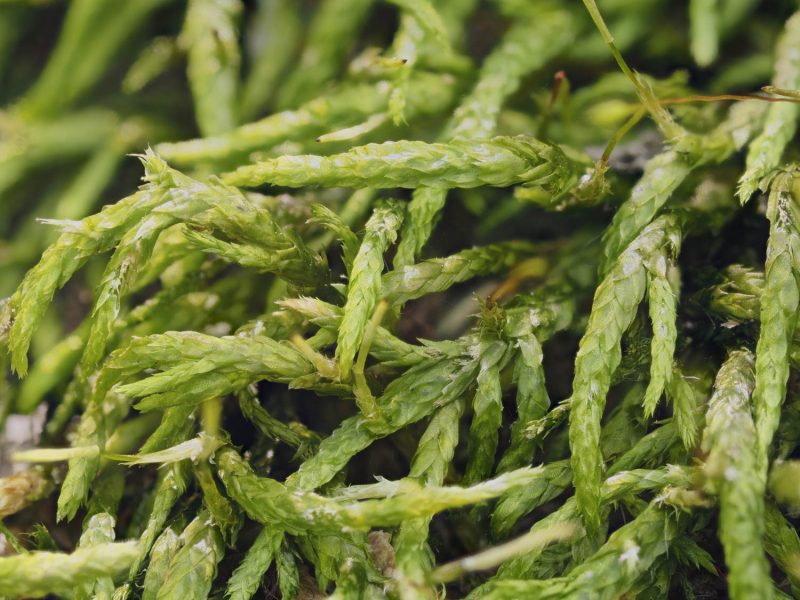
Entodon seductrix is a shiny pleurocarp common on logs.
The coefficient of conservatism for the site, computed as the sume of the 49 individual species CC values divided by the square root of the number of species present, is 14.4. This is a fairly low number, influenced by the fact that it includes species from the disturbed border and path communities, mixing them with the more intact woods community. A more refined approach will be to compute separate FQAI scores for each of the communities.
SPECIES LIST
Aceraceae, the Maple Family
Acer negundo L. BOX ELDER CC=3 Native Tree (woods)
Acer saccharinum L. SILVER MAPLE CC=3 Native Tree (woods)
Acer saccharum Marshall SUGAR MAPLE CC=5 Native Tree (woods)
Anacardiaceae, the cashew Family
Toxicodendron radicans (L.) Kuntze POISON-IVY CC=1 Native Woody Vine (border and woods)
Anonaceae, the custard-apple Family
Asimina triloba (L.) Dunal PAWPAW CC=6 Native Tree (woods)
Conium maculatum L. POISON-HEMLOCK CC=0 Alien Biennial (border)
Apocynaceae, the Dogbane Family
Asclepias syriaca L. COMMON MILKWEED CC=1 Native Perennial (path)
Asteraceae, the Aster Family
Ambrosia artemisiifolia L. COMMON RAGWEED CC=0 Native Annual (border)
Ambrosia trifida L. GIANT RAGWEED CC=0 Native Annual (border)
Arctium lappa L. GREAT BURDOCK CC=0 Alien Biennial (border)
Bidens frondosa L. DEVIL’S BEGGAR’S-TICK CC=2 Native Annual (path)
Cichorium intybus L. CHICORY CC=0 Alien Perennial (border)
Cirsium arvense (L.) Scop. CANADA THISTLE CC=0 Alien Perennial (border)
Conyza canadensis (L.) Cronquist HORSEWEED CC=0 Native Annual (border and path)
Erechtites hieracifolia (L.) Raf. ex DC. PILEWORT CC=2 Native Annual (path)
Solidago canadensis L. CANADA GOLDENROD CC=1 Native Perennial (border)
Symphyotrichum lanceolatum (Willd.) G.L. Nesom EASTERN LINED ASTER CC=3 Native Perennial (border and path)
Bignoniaceae, the Bignonia Family
Catalpa sp. Scop. CATALPA CC=0 Alien Tree (path)
Boraginaceae, the Borage Family
Hackelia virginiana (L.) I. M. Johnst. VIRGINIA STICKSEED CC=2 Native Biennial (path and woods)
Caprifoliaceae, the Honeysuckle Family
Lonicera maackii (Rupr.) Maxim. AMUR HONEYSUCKLE CC=0 Alien Shrub (path and woods)
Celastraceae, the Winter-creeper Family
Euonymus fortunei (Turcz.) Hand.-Mazz. WINTERCREEPER CC=0 Woody Vine (woods)
Cyperaceae, the Sedge Family
Carex frankii Kunth FRANK’S SEDGE CC=2 Native Perennial Graminoid (path)
Dipsacaceae, the Teasel Family
Dipsacus fullonum L. WILD TEASEL CC=0 Alien Biennial (border)
Fabaceae, the Legume Family
Robinia pseudoacacia L. BLACK LOCUST CC=0 Native Tree (border and path and woods)
Fagaceae, the Beech Family
Fagus grandifolia Ehrh. AMERICAN BEECH CC=7 Native Tree (woods)
Quercus rubra L. NORTHERN RED OAK CC=6 Native Tree (woods)
Juglandaceae, the Walnut Family
Carya laciniosa (F. Michx.) Loudon SHELLBARK HICKORY CC=7 Native Tree (woods)
Juglans nigra L. BLACK WALNUT CC=5 Native Tree (woods)
Lauraceae, the Laurel Family
Lindera benzoin (L.) Blume SPICEBUSH CC=5 Native Shrub (woods)
Monotropaceae, the Monotropa Family
Monotropa unifolora L. Indian Pipe CC=5 Native Perennial (woods)
Moraceae, the Mulberry Family
Morus alba L. WHITE MULBERRY CC=0 Alien Tree border and path)
Oleaceae, the Olive Family
Fraxinus nigra Marshall BLACK ASH CC=7 Native Tree (woods)
Fraxinus pennsylvanica Marshall GREEN ASH CC=3 Native Tree (woods and path)
Phytolaccaceae, the Pokeweed Family
Phytolacca americana L. POKEWEED CC=1 Native Perennial (path)
Plantaginaceae, the Plantain Family
Plantago lanceolata L. ENGLISH PLANTAIN CC=0 Alien Perennial )border)
Platanaceae, the Plane-tree Family
Platanus occidentalis L. SYCAMORE CC=7 Native Tree (path and woods)
Poaceae, the Grass Family
Dactylis glomerata L. ORCHARD GRASS CC=0 Alien Perennial Graminoid (border)
Phragmites australis ssp. australis (Cav.) Trin. GIANT REED CC=0 Alien Perennial Graminoid (path)
Setaria glauca (L.) P. Beauv. YELLOW FOXTAIL GRASS CC=0 Alien Perennial Graminoid (border and path)
Tridens flavus (L.) Hitchc. GREASE GRASS CC=1 Native Perennial Graminoid (path)
Polygonaceae, the Smartweet Family
Fallopia convolvulus (L.) A. Love BLACK BINDWEED CC=0 Alien Annual (border)
Persicaria virginiana (L.) Gaertn. JUMPSEED CC=3 PE Native Perennial (border)
Polygonum aviculare L. COMMON KNOTWEED CC=0 Alien Annual (border)
Rosaceae, the Rose Family
Rosa multiflora Thunb. ex Murray MULTIFLORA ROSE CC-0 Alien Shrub (woods)
Rubus allegheniensis Porter COMMON BLACKBERRY CC=1 Native Shrub (border and path)
Salicaceae, the Willow Family
Populus deltoides W. Bartram ex Marshall EASTERN COTTONWOOD CC=3 Native Tree (woods)
Scrophulariaceae, the Figwort Family
Scrophularia marilandica L. MARYLAND FIGWORT CC=4 Native Perennial (path)
Ulmaceae, the Elm Family
Celtis occidentalis L. HACKBERRY CC=4 Native Tree (woods)
Ulmus americana L. AMERICAN ELM CC=2 Native Tree (woods)
Verbenaceae, the Vervain Family
Verbena urticifolia L. WHITE VERVAIN CC=3 Native Perennial (path)
Vitaceae, the Grape Family
Parthenocissus quinquefolia (L.) Planch. VIRGINIA CREEPER CC=2 Native Woody Vine (woods)
Vitis riparia Michx. RIVERBANK GRAPE CC=3 Native Woody Vine (woods)
CONSERVATIVE PLANTS
Exemplifying the fact that highly conservative plants are not necessarily rare plants, the forest trees at the woodlot are generally the ones with the highest CC values. American sycamore, Platanus occidentalis, CC=7, is a distinctive bottomland tree that can become quite huge, not so much in height but girth. Some early colonists lived in hollow American sycamore trees while their permanent homes were under construction! The American sycamores here are much smaller; indeed most of them are mere saplings. By the way, one should always try to include the modifier “American” when naming this tree, as the common name “sycamore” is somewhat ambiguous. Europeans use that name to mean maples (genus Acer).
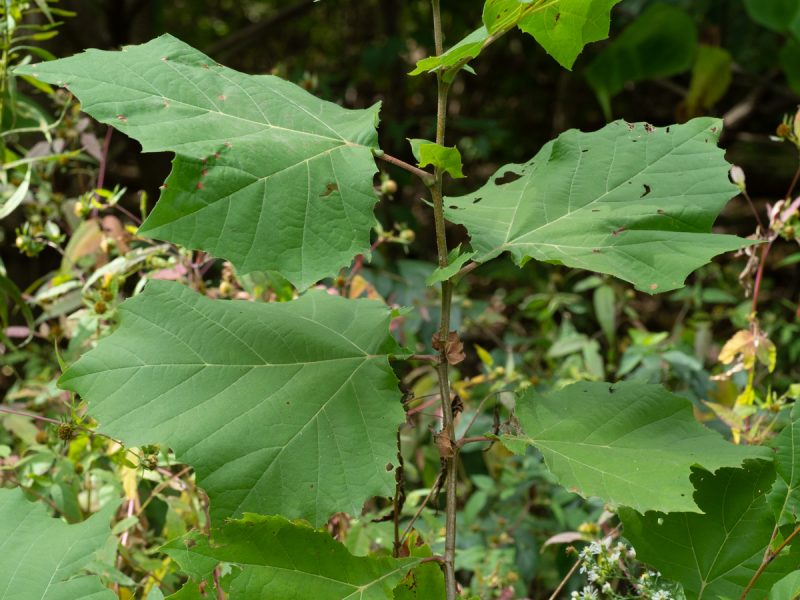
American sycamore is a lowland tree. Note the prominent stipules.
Other high CC trees here are American Beech (CC=7), and the above-mentioned black ash (CC=7), and a few other with a CC of 5 or greater. For variety though, and because it was such a pleasant surprise, take a look at this cool herb with a CC of 5, Indian Pipe, Monotropa uniflora, that was seen in fruit. The fruiting plants are erect, not so pipe-like.
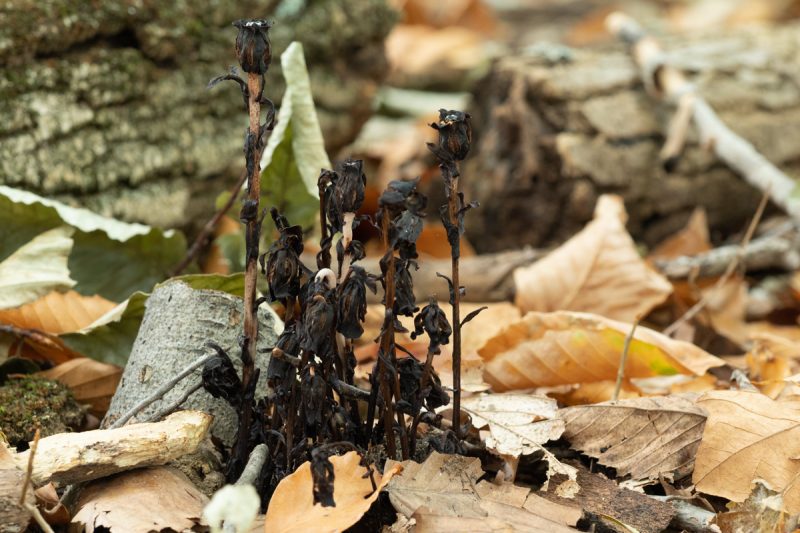
Indian pipe is a parasite on soil fungi.
WEEDY (LOW CC) PLANTS
Unfortunately, there are a lot to choose from in the low CC category. This is a very disturbed site that could use some management. One interesting point well illustrated by this site is that not all CC=0 plants are alien weeds. Several native plants that are adapted to localized disturbances such as windthrows and landslides do quite well in urban and agricultural settings. Here are two such native plants.
Horseweed, Conyza canadensis, is a member of the aster family with small radiate capitula. It’s a bad weed in corn fields, and, to the worry and aggravation of farmers, it has been developing resistance to glyphosphate (“Roundup”) herbicides.
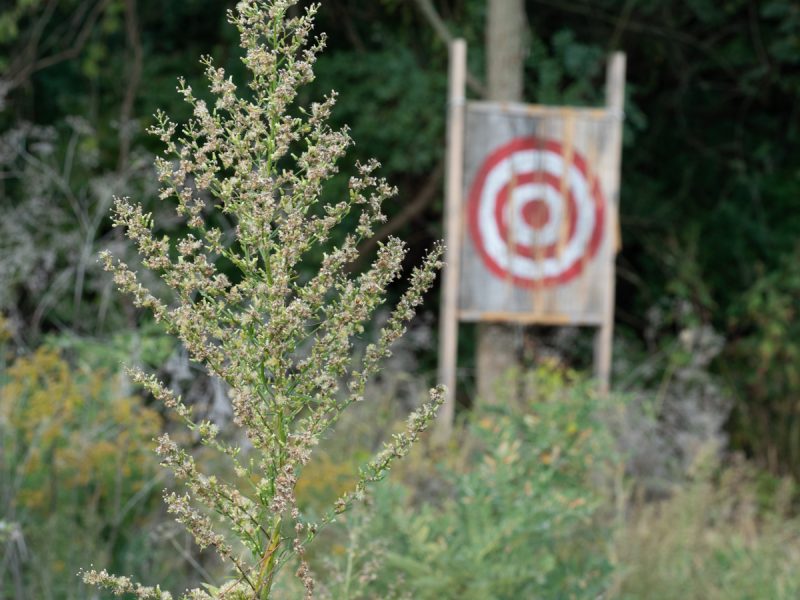
Horseweed is a bad weed in agricultural systems.
Ragweed, Ambrosia artemsiifolia, is a wind-pollinated member of the aster family. It produces unisexual flowers in separate inflorescences. Prominent in the photo below, the male flowers are more numerous, aggregated into capitula on an elogate upright spike.

Ragweed is a wind-pollinated annual.
